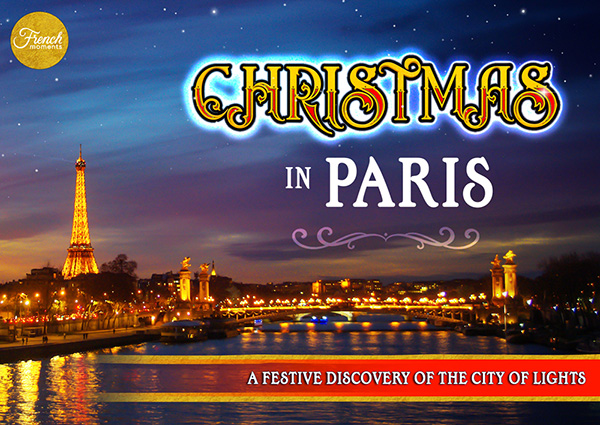Riding his black horse, he roams the countryside of northern Alsace with a vengeance. Hans Trapp is the terror of Alsatian gatherings. On St Nicholas' Eve, he proudly takes part in the procession of the holy man in Wissembourg and other towns in the region. Here's a look at the bogeyman of Alsatian children's nightmares...
Hans Trapp
In Alsace, three Christmas characters co-exist:
- Christkindel officiates at Christmas, handing out presents to children.
Saint-Nicolas rewards children who have been good over the past year AND then there's : - Hans Trapp, a bloodthirsty brute who punishes naughty children.
- Père Fouettard terrorises children in Lorraine? The toddlers of Alsace had better watch out because the fearsome Hans Trapp was lurking nearby. The Vosges have done things right: each side of the Vosges, whether in Alsace or Lorraine, has its own terror of 6 December.
That said, outside the north-east of France, Hans Trapp remains little known, unlike the Père Fouettard of Lorraine, whose fame has spread beyond the French countryside.
Nonetheless, Hans Trapp's character deserves an article on my blog. You'll be in for a treat if you like stories about wakes. Because the story of the abominable Trapp would be better suited to Halloween than Christmas. Let's go back in time to the 16th century.
The knight Hans von Trotha
Let's head for the Wissembourg region in the far north of Alsace, bordering the German Palatinate. In the 15th century, there was no border between France and Germany at Wissembourg, which was part of the Holy Roman Empire.
The story of Hans Trapp begins at Berwartstein Castle in the Palatinate. This pink sandstone fortress, located 15 km north of Wissembourg, was awarded in 1480 to a certain Hans von Trotha (or Jean de Dratt) by the Elector of the Palatinate. The knight von Trotha, born around 1450 in Krosigk (now in Saxony-Anhalt), was praised for his merits. A few years later, the Prince even raised him to the prestigious rank of Marshal of the Prince-Electors of the Palatinate.
The Elector had acquired Berwartstein Castle and its outbuildings 30 years earlier, in 1450.
The Abbot of Wissembourg, the former owner of the site, protested that things had not been done properly. He denounced the existence of irregularities in the acquisition of Berwartstein... so much so that when the monks learned that the castle had been given to "an ambitious foreigner" who wanted more and more, they appealed to the Elector in Heidelberg. He decided ... in favour of Hans Von Trotha!
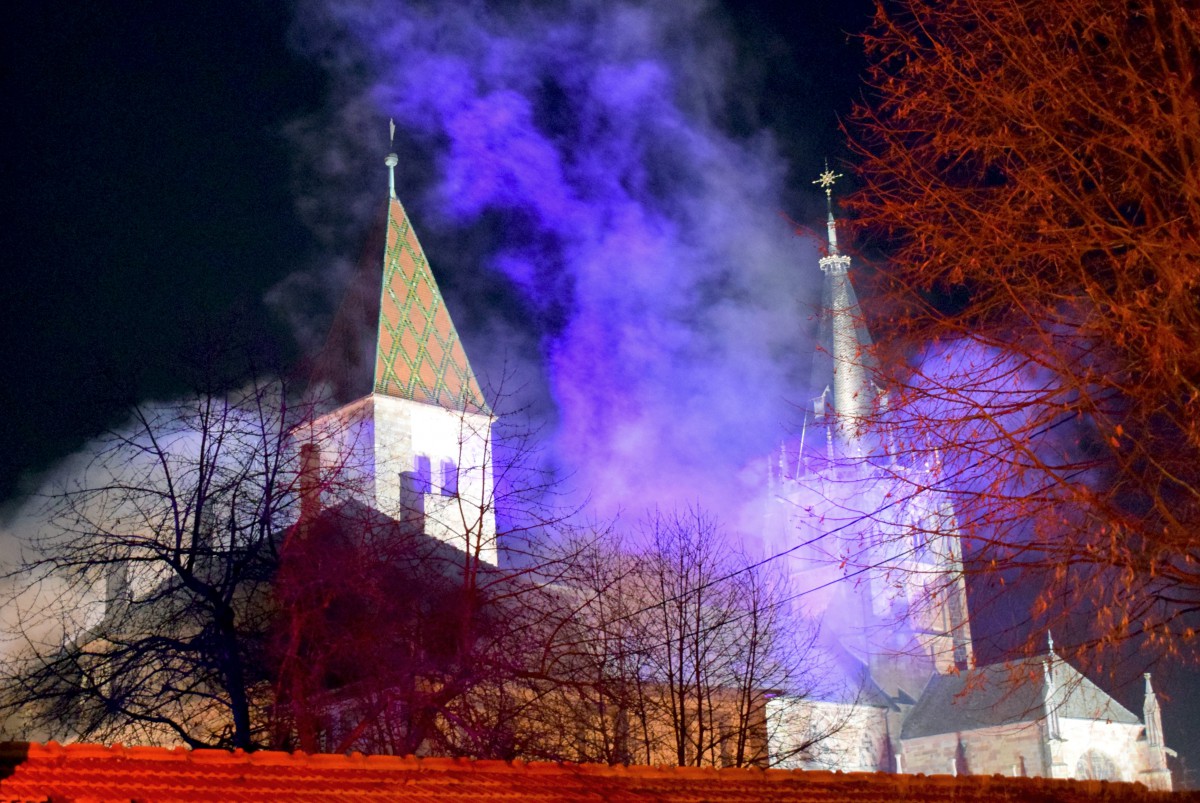
Wissembourg © French Moments
The revenge of Hans von Trotha
The monks must have given the knight such a hard time that he came up with the idea of retaliation. What was crucial for a town in the Middle Ages? Access to water.
Trotha built a dam to stop the waters of the Wieslauter from flowing into the town of Wissembourg. The river was diverted upstream of the town. An artificial lake formed, flooding the abbot's land.
The monks, furious and distraught, protested and demanded that the water be returned to their town. Trotha mischievously breached the dam. The water rushed down the slope and severely flooded Wissembourg. This disaster caused serious economic damage to the town.

The river running through Wissembourg © French Moments
Punishment from the Pope
The abbot appealed several times to the Holy Roman Emperor. To no avail. He had one card left to play: the Pope. He pleaded his case with Pope Innocent VIII.
After 8 years, he finally found favour with Pope Alexander VI. Hans von Trotha was summoned to appear before the papal tribunal in Rome. He refused to go. He wrote a letter proclaiming his loyalty to the Church... and took the opportunity to take a few swipes at the Pope, accusing him of immorality (although he wasn't entirely wrong!). The response was swift: Hans von Trotha was excommunicated, i.e. banished from society... and from the Church.
Trotha despised this punishment, and two years after his death, the sanction was lifted posthumously.
To avoid the same fate, his former protector, the Elector, had to give up his protégé. But thanks to his diplomatic skills, he found a way out for Hans: he sent him temporarily to the French royal court during the Italian wars. There, King Louis XII awarded him the title of Golden Knight.
Hans von Trotha died on 26 October 1503 at his Berwartstein Castle. And so the legend goes...
A lineage without descendants
Hans von Trotha married Anna Helmstatt, from a noble family in south-west Germany and Lorraine. They had an only son, Christoph, who inherited Berwartstein Castle in 1511, thanks to the investiture of Prince-Elector Ludwig V the Pacific.
Christoph married Margaretha Sturmfeder von Oppenweiler, but their common daughter Martha, who was married to Frederick the Elder of the Alsatian noble family of Fleckenstein, died prematurely in 1536. Christoph died without male descendants in 1545.
The inheritance, which consisted mainly of feudal dominion over the castles of Berwartstein and Grafendahn, went to Christoph's widowed son-in-law, Friedrich the Elder of Fleckenstein.
Thus, Hans von Trotha's line died out some forty years after his death, contributing to the legend that follows...
Hans Trapp, the diabolical outbidder
In the centuries following his death, local custom attributed to Hans von Trotha all the attributes of a diabolical figure. A bloodthirsty brute, debauched, power-hungry and violent. His sole aim was to terrorise the population by pillaging travellers and peasants. He was even accused of making a pact with the devil. In local tradition, he became a bogeyman in search of human flesh. God himself is said to have punished him by turning him into a scarecrow for devouring a young shepherd.
His name was deformed into Hans Trapp, trappen meaning to make a noise while walking to chase away spirits. This is why it is said of the dark character that he wanders at night without rest in the deep, dark forest around Berwartstein Castle.
The monks of Wissembourg had their revenge! The name and reputation of their adversary were sullied forever... one might even pity the memory of poor Hans von Trotha.
What does Hans Trapp look like?
In Alsatian tradition, Hans Trapp is like a twin brother to the Père Fouettard of Lorraine. However, he has a few characteristics all his own.
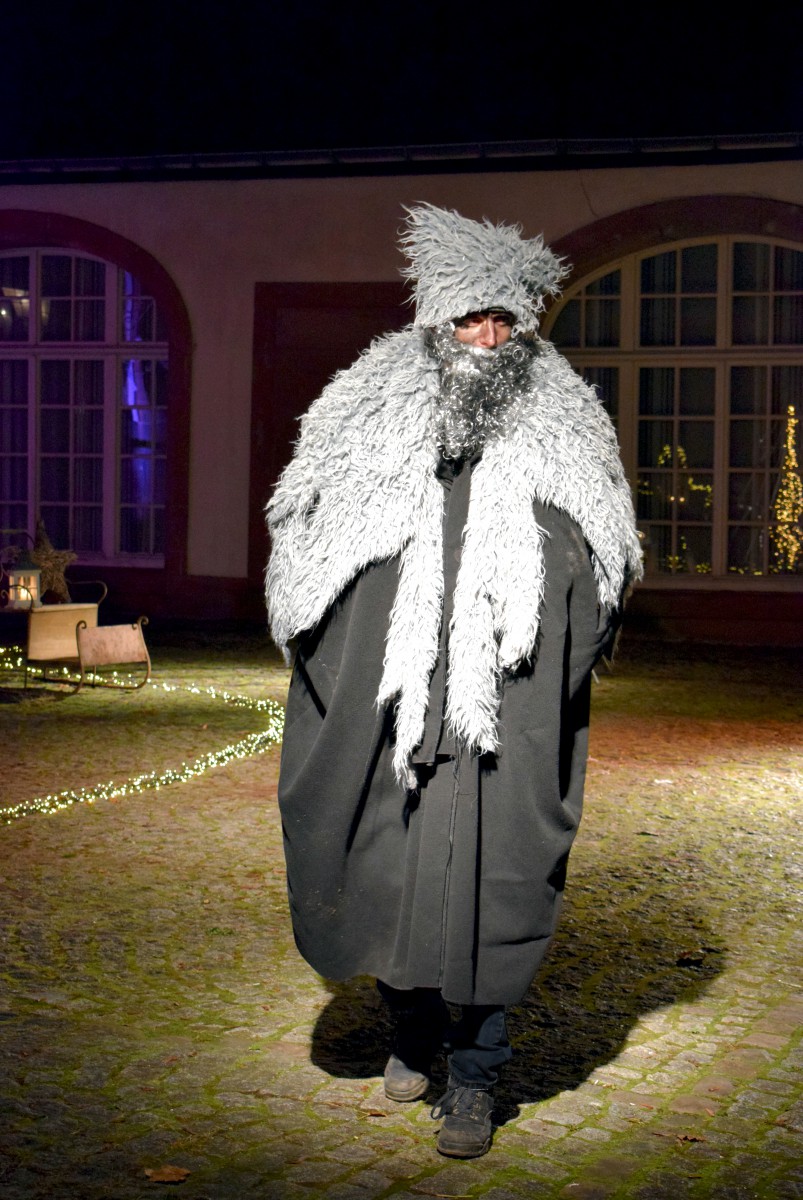
The terrifying Hans Trapp in Wissembourg © French Moments
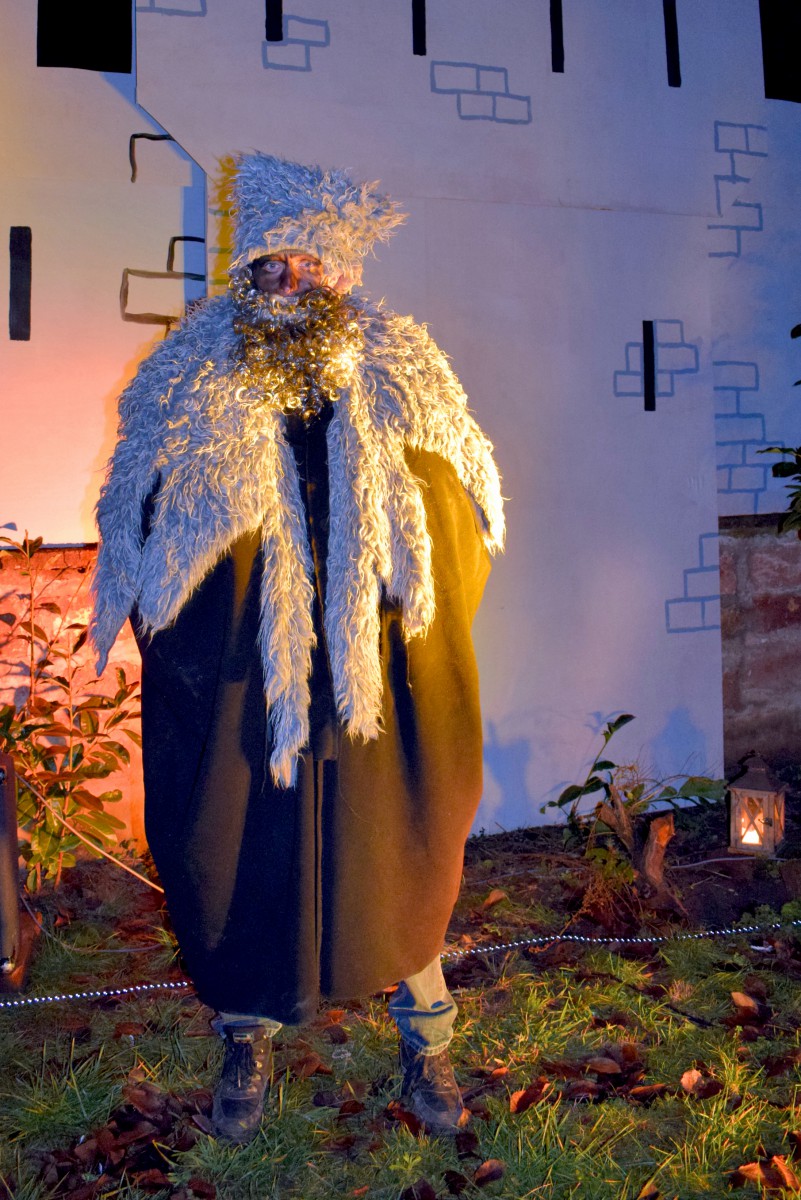
Hans Trapp in Wissembourg © French Moments
An Alsatian poem about Hans Trapp
A famous Alsatian dialect poem describes Hans Trapp's appearance (white beard, pointed hood and rod):
D’r Hans Trapp
Schoi, do kummt d’r Hans Trapp.
Ar het a scheni Zepfelkapp’
Un a Bart wiss wie a Schimmel.
Ar kummt vum schena Starnehimmel
Un bringt da Kinder a Ruada,
Wu net dien singe un bata.
Schoi, Hans Trapp, mir sin so klein
Un brav un folje d’heim.
Müesch net kumme mit dim Stacka,
Denn mir kenne singe un oi bata.
The Hans Trapp
Look, there's Hans Trapp.
He's got a nice pointed hood
And a beard as white as a white horse.
He comes from the starry sky
He brings a rod to the children
Who neither sing nor pray.
Look, Hans Trapp, we are so small
We are wise and we follow the house.
You don't need to come with your rod,
For we know how to sing and pray.
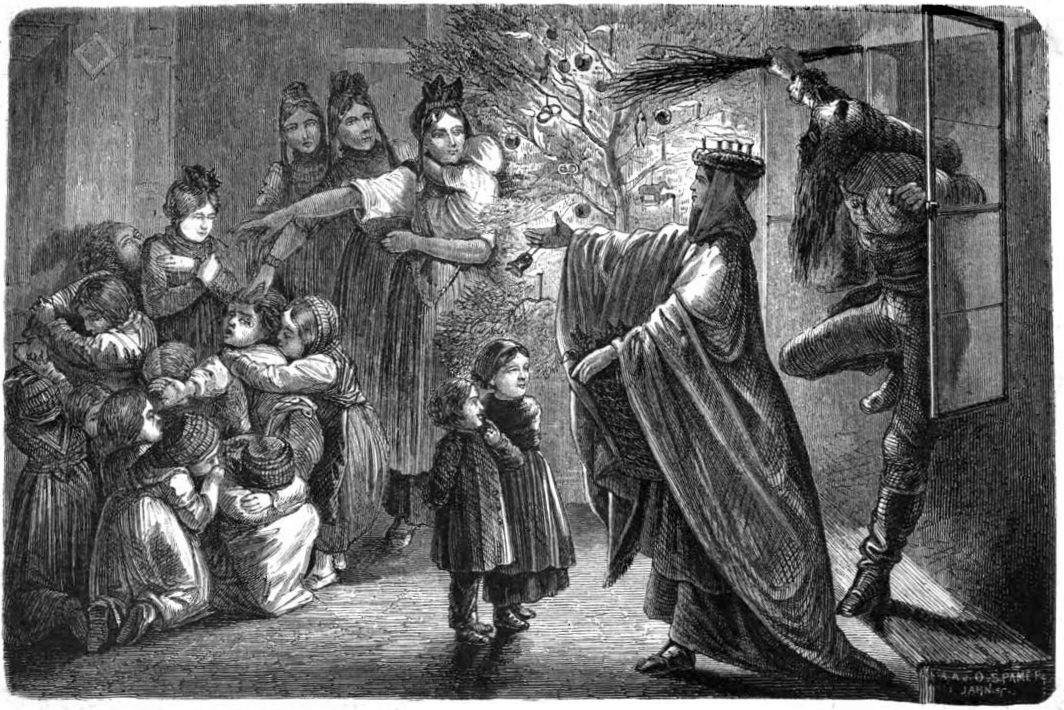
Christkindel and Hans Trapp visiting an Alsatian family (1858)
He is a hateful, dark and associative character:
- Hans Trapp is 2 metres tall - which must have been impressive in the 15th century!
- He is dressed in a black greatcoat and is wearing big black boots that make a lot of noise when he walks.
- The man has a long white beard and a pointed hat.
- He is holding a rod in his hand to beat recalcitrant children.
- This robber-knight appears on horseback, notably during the
- Hans Trapp parade in Wissembourg.
- He speaks only German (in fact the local dialect of the Wissembourg region).
- In some Alsatian villages, the abominable villain is known as Hans Nìckel or Rübbels.
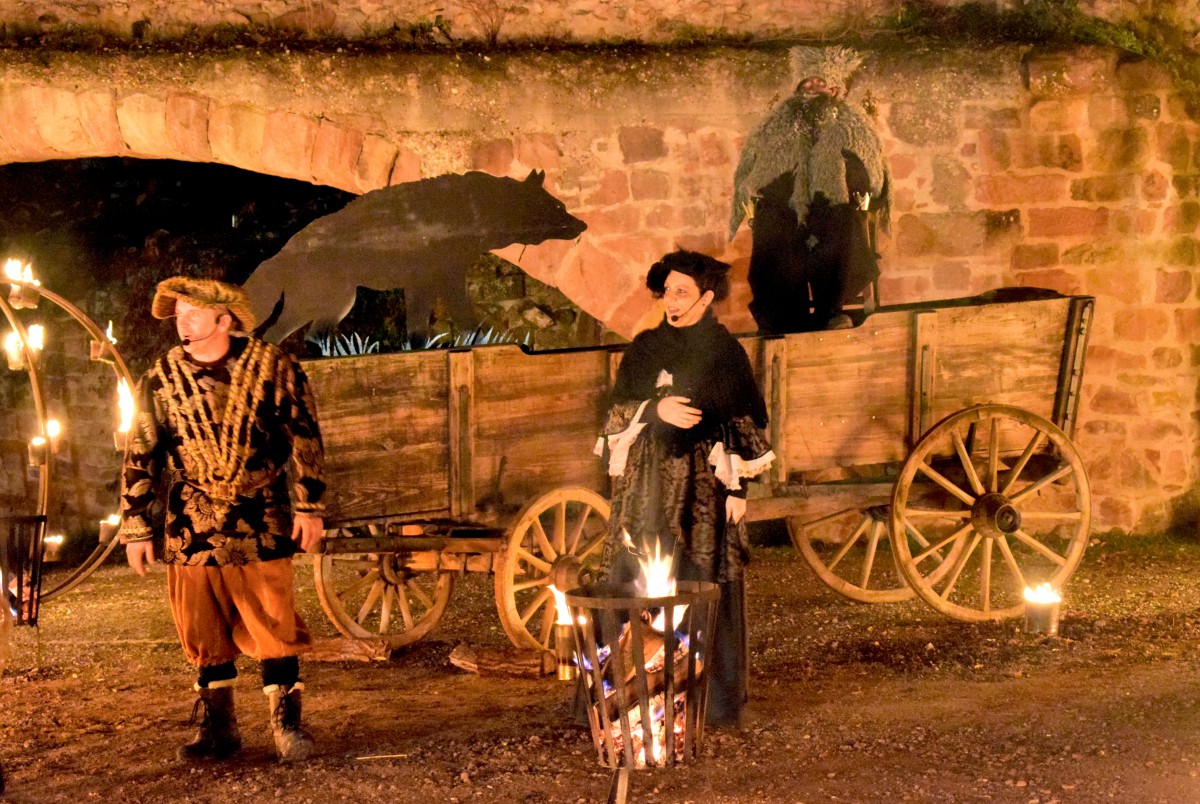
Hans Trapp's companions in Wissembourg © French Moments
Meet Hans Trapp at the night parade
Do you really want it? If so, it's in Alsace that you're most likely (or unlucky, depending!) to come across it.
There's even an ideal place to catch a glimpse of it on a December evening: Wissembourg. Every year, the former city of the abbots at war with Hans von Trotha organises a night parade with Hans Trapp and Christkindel.
It takes place on the evening of the 4th Sunday in Advent in the streets of the old town, with a grand finale at the foot of the abbey church. The procession begins with the monks.
Then come the fire jugglers and percussionists in a deafening din. They announce the imminent arrival of Hans Trapp. He appears on horseback but takes the time to put his foot down and ask the spectating children if they have been good.
To dissuade them from misbehaving, a carriage approaches with a cage full of child prisoners imploring the crowd to "free us, help us" (you'll have realised that these are young aspiring actors 🙂 ).
The atmosphere soon mellows with the arrival of the Christkindel light float. The festivities end with a fireworks display.
Find out more about the Hans Trapp parade in Wissembourg.
The Hans Trapp walk
The story does not simply end with a night parade in Wissembourg. Confronted with the arrival of the Light, symbolised by Christkindel, Hans Trapp withdrew, admitting defeat. According to local tradition, the people of Wissembourg drive him back to his lair at Berwartstein Castle, thus celebrating the victory of good over evil. An enchanting conclusion to this wintry tale.
Every year at the end of December, the Alsace verte tourist office organises a guided walk that includes visits to Hans Trapp's tomb at the Chapelle Sainte-Anne and the Klein Frankreich watchtower. The 11km route starts in Niederschlettenbach in Germany, just 12km from Wissembourg, heading towards Berwartstein Castle. Once at Hans Trapp's lair, hikers can enjoy a meal of Palatine specialities in the castle courtyard. An excellent opportunity to discover Burg Berwartstein, just a stone's throw from Wissembourg.
Find out more about the Hans Trapp hike in Wissembourg.
Berwartstein Castle
Berwartstein (also known as Bärbelstein or Bärwelstein) is a medieval castle located in the southern Palatinate Forest, the German part of Vasgovia (Wasgau) in Rhineland-Palatinate. Rebuilt around 300 years after being destroyed by lightning in the 1890s, it is the only castle still inhabited in Vasgovia.
Location of the castle in Vasgovia
Situated in the Südwestpfalz district, to the south of the municipality of Erlenbach, near Dahn, at an altitude of 277 metres on the western foothills of the Grünberg (411 metres), Berwartstein overlooks a side valley through which the Erlenbach flows for around 3 km to the south between Dahn and Wissembourg (Weißenburg in German).
When the story began
The first mention of Berwartstein dates back to 1152 when Emperor Frederick Barbarossa gave it to the Bishop of Speyer, Günther. In the 13th century, the fortress was administered on behalf of the Bishop of Speyer by a family bearing the name of the castle. Accused of predation, the Berwartsteiner saw their castle taken and dismantled around 1314 by troops from the Alsatian towns of Strasbourg and Haguenau after a five-week siege. The Berwartsteiner dynasty kept the castle (or what was left of it) until its extinction in 1345.
The castle thus passed into the hands of the Weingarten family, who sold the castle and its outbuildings to Wissembourg Abbey in 1347 for the sum of 800 florins. As an imperial fief, Emperor Ludwig III of Bavaria confirmed this transaction in 1347. More than a century later, in 1453, the abbey came under the protection of the Elector of the Palatinate.
The lair of Hans von Trotha
Despite persistent protests from the abbey, which continued to consider itself the owner, in 1480 Elector Philip I of the Palatinate handed the castle over to his marshal, Hans von Trotha, as a hereditary fief. During his reign, the castle was further strengthened. In 1484, Hans von Trotha had an outpost built to the south, opposite the main castle, at a distance of 370 metres as the crow flies, with a 14-metre thick tower, later known by the popular name of "Little France" (Klein-Frankreich).
When Hans von Trotha's son Christoph died without issue in 1545, his son-in-law Friedrich inherited the castle from the Fleckenstein family. In 1590, it was destroyed by a fire caused by lightning and remained in ruins thereafter.
The aftermath of "von Trotha"
Over the centuries, the ruin changed ownership several times until it fell into the hands of Theodor von Baginski (1845-1929) in 1893. In two years, he rebuilt and extended Berwartstein, where he lived from 1899 until his death. Although partially restored, the castle is still privately owned and used as a residence.
![Berwartstein © Claus Ableiter - licence [CC BY-SA 3.0] from Wikimedia Commons Berwartstein © Claus Ableiter - licence [CC BY-SA 3.0] from Wikimedia Commons](https://frenchmoments.eu/wp-content/uploads/2023/12/Berwartstein-©-Claus-Ableiter-licence-CC-BY-SA-3.0-from-Wikimedia-Commons.jpg)
Restored parts of Berwartstein, circa 1890 © Claus Ableiter - licence [CC BY-SA 3.0] from Wikimedia Commons
A castle-rock
Like many of the region's castles, Berwartstein is a stone castle carved mainly from pink sandstone. Staircases, corridors and chambers are carved into the rock, forming an intricate cave system that runs through the great rock of the Oberburg.
At first glance, Berwartstein gives the impression of being a perfectly preserved castle, but it is important to note that most of the structures are later additions to the original rock castle structure. These additions date from the 1890s, a period of restoration and reconstruction. So, as with the contemporary reconstruction of Haut-Kœnigsbourg castle in Alsace, some of the restored elements are not entirely faithful to the original.
The castle's well
The castle well, dug by hand into the rock, reaches a depth of 75 metres and has a constant diameter of 2 metres. It provided a water supply during sieges, guaranteeing the castle's successful defence.
The decoration of the Knights' Hall at Berwartstein Castle evokes Hans von Trotha's 'aquatic' battle against Wissembourg Abbey. This room, which can seat 150 people, is now used as a restaurant and is still open to visitors.
Have you met Hans Trapp? Let us know by leaving a comment!
About the illustrations in the article
Most of the photos are ours (© French Moments). However, I have selected some photos (including the Featured Image of this article) from Depositphotos, a commercial platform that brings authors of high-quality licensed stock photos, graphics, vectors and videos together with appreciative buyers.

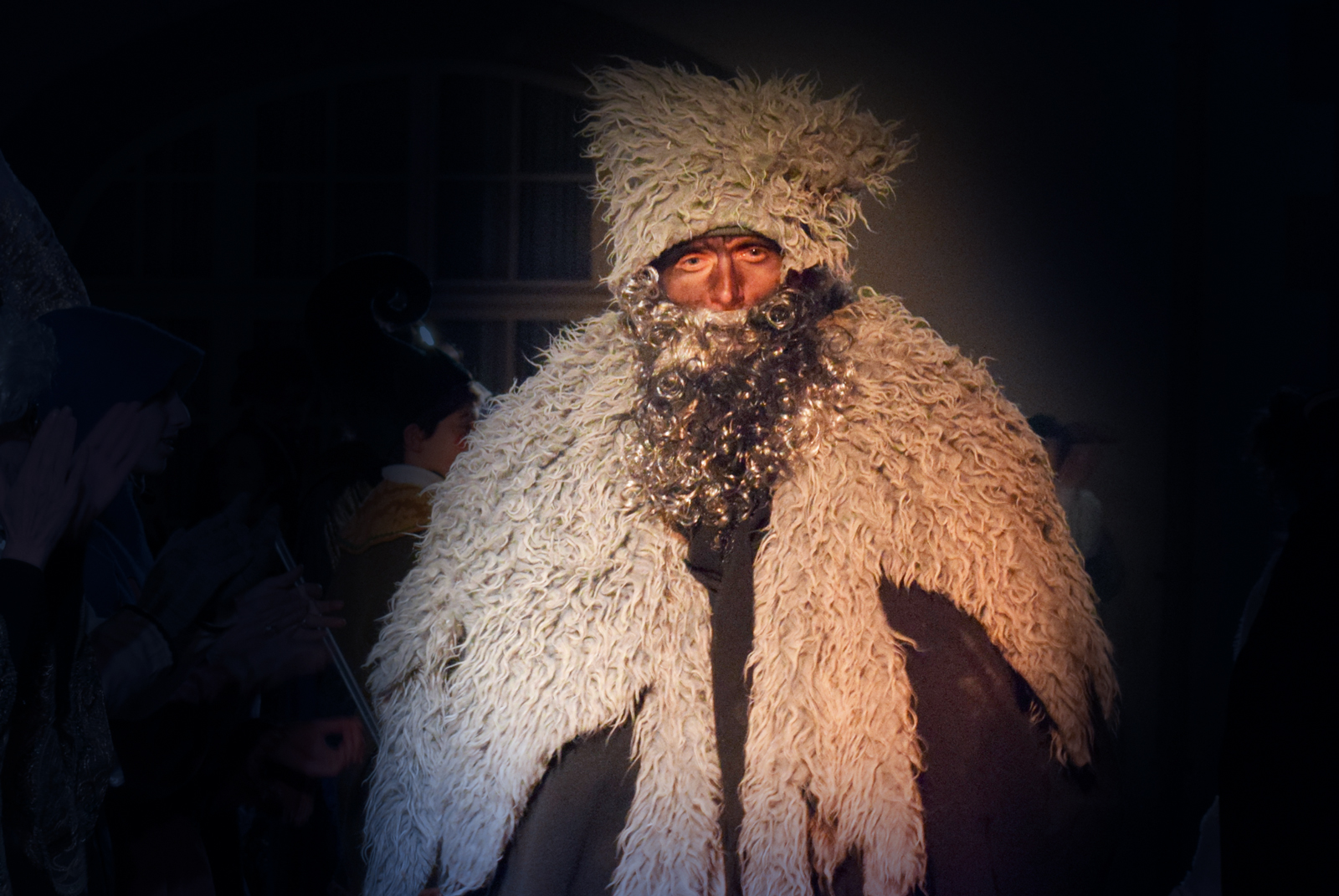

![Berwartstein Halloween © Ulli1105 - licence [CC BY-SA 3.0] from Wikimedia Commons Le château du Berwartstein © Ulli1105 - licence [CC BY-SA 3.0] from Wikimedia Commons](https://frenchmoments.eu/wp-content/uploads/2023/12/Berwartstein-Halloween-©-Ulli1105-licence-CC-BY-SA-3.0-from-Wikimedia-Commons.jpg)
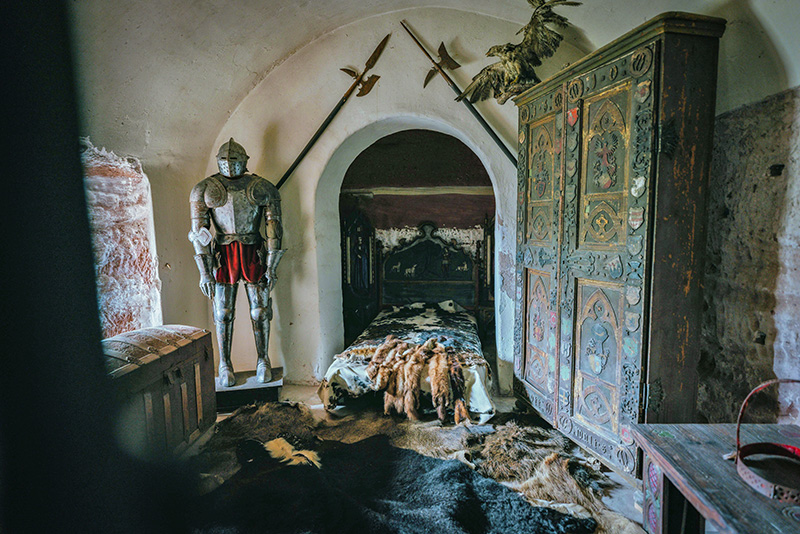
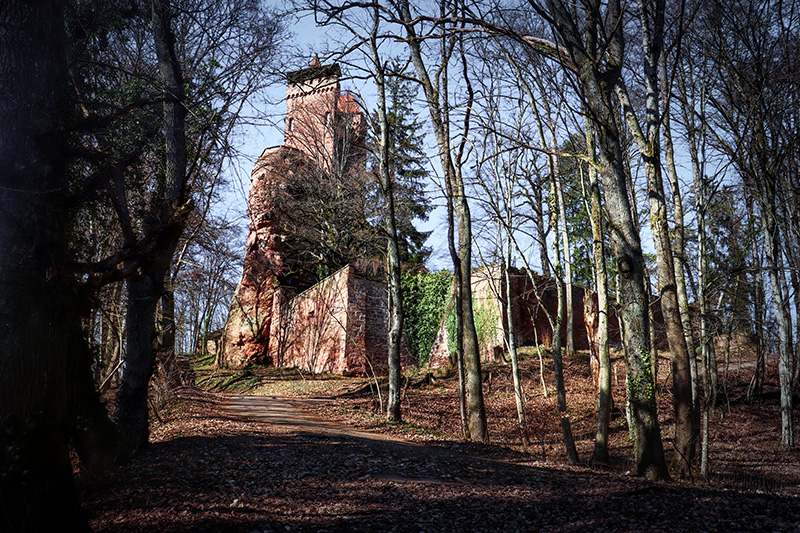
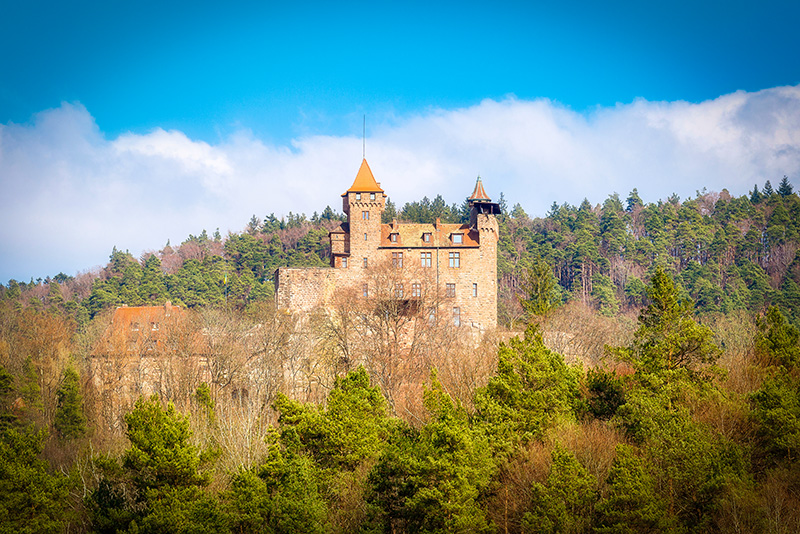
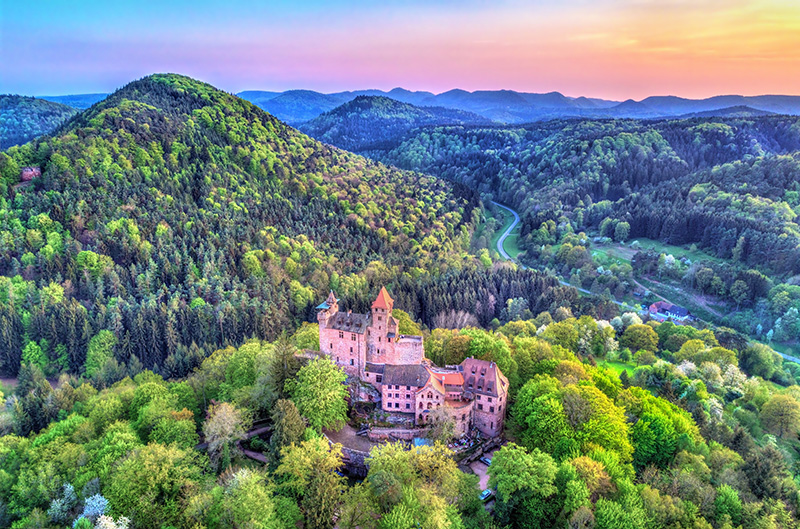
![Berwartstein Kapelle © Lokilech - licence [CC BY-SA 3.0] from Wikimedia Commons Berwartstein Kapelle © Lokilech - licence [CC BY-SA 3.0] from Wikimedia Commons](https://frenchmoments.eu/wp-content/uploads/2023/12/Berwartstein-Kapelle-©-Lokilech-licence-CC-BY-SA-3.0-from-Wikimedia-Commons.jpg)
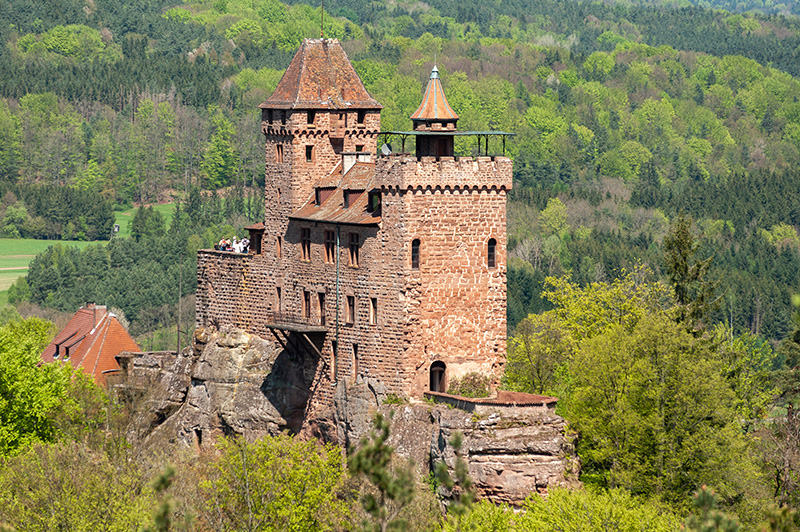
![Berwartstein © H. Zell - licence [CC BY-SA 3.0] from Wikimedia Commons Berwartstein © H. Zell - licence [CC BY-SA 3.0] from Wikimedia Commons](https://frenchmoments.eu/wp-content/uploads/2023/12/Berwartstein-©-H.-Zell-licence-CC-BY-SA-3.0-from-Wikimedia-Commons.jpg)
